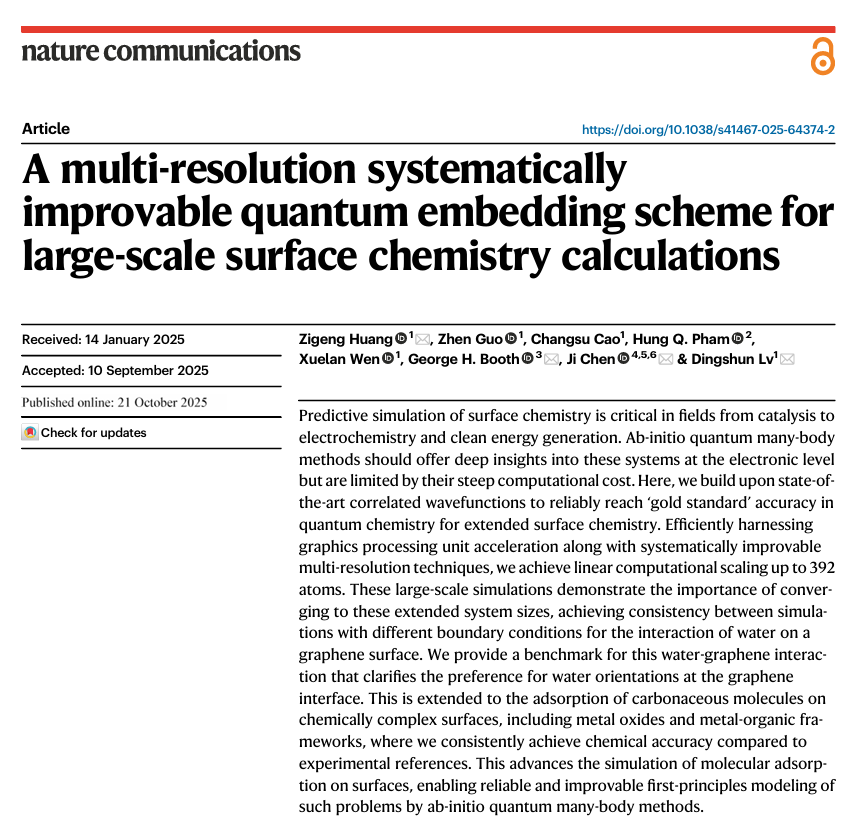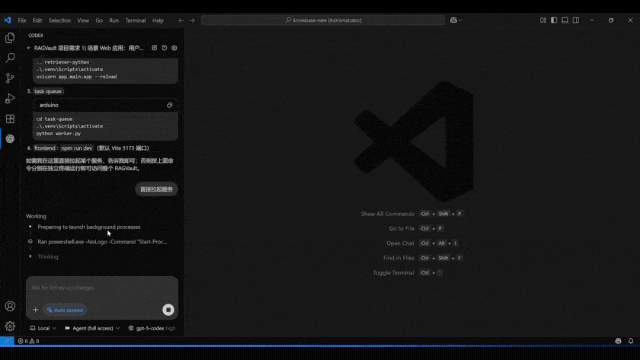# Bringing the “Gold Standard” of Quantum Chemistry to Real-World Materials
*2025-11-09 19:47 Beijing*

---
## Introduction
**Making the “gold standard” of quantum chemistry applicable to practical material systems.**

Computation now underpins much of modern science — from **drug and protein design** to **material discovery**, researchers aim to run *virtual experiments* on computers to predict matter’s properties. Achieving this requires **precise simulation** of nuclei–electron interactions within atoms.
If precision is lacking, catalysts could be wrongly dismissed or material properties misjudged — wasting years of effort and resources.
---
## The Challenge
Algorithms like **CCSD(T)**, long considered *quantum chemistry’s gold standard*, deliver experiment-level answers **only for small molecules**.
Why CCSD(T) struggles with real materials:
- **Scale problem:** Real systems contain tens of thousands of electrons.
- **Computation explosion:** Costs grow dramatically with system size.
- **Past limitations:** Usable only for tiny, simplified models — making direct studies of catalysts, electrochemical systems, or battery interfaces impossible.
---
## Breakthrough: SIE+CCSD(T)
The **Seed AI for Science** team at ByteDance, together with **Professor Ji Chen** (Peking University) and **Professor George H. Booth** (King’s College London), have proposed a **new quantum embedding framework**:
> **SIE+CCSD(T)** — integrating the “gold standard” CCSD(T) with GPU-optimized computation.
**Key result:** For the first time, CCSD(T)-level simulations can run on **real-material systems** with tens of thousands of orbitals and hundreds of atoms.
Scientific impact:
- Enables *experiment-level precision* in complex surface studies.
- Provides a dependable theoretical basis for **catalyst design**, **clean energy research**, and **new materials development**.
**Publication:**
- *Nature Communications*, 21 October 2025
- **Article:** [https://www.nature.com/articles/s41467-025-64374-2](https://www.nature.com/articles/s41467-025-64374-2)
- **Code:** [https://github.com/bytedance/byteqc/tree/main/embyte](https://github.com/bytedance/byteqc/tree/main/embyte)

---
## Highlights at a Glance
### 1. Large-Scale, High-Precision
- Example: **Graphene** with 392 carbon atoms (~11,000 orbitals).
- **SIE+CCSD(T)** reached full CCSD(T)-level accuracy.
- GPU execution displayed **near-linear scaling** — a major leap toward practical use.
### 2. Controllable and Systematically Improvable Accuracy
- Flexible integration of multiple precision algorithms.
- **Unique screening method** retains only the most relevant orbitals and electrons.
- Researchers can **adjust precision vs. speed** as required.
### 3. Cross-System Validation
- Tested on **MgO surfaces**, **CPO-27-Mg frameworks**, and **graphene**.
- Match with experiments within ±1 kcal/mol — achieving **chemical accuracy**.
### 4. Eliminating Boundary Condition Conflicts
- Resolved open vs. periodic boundary discrepancies in water adsorption on graphene.
- Adsorption energies converged to below significant differences (~100 meV).
- Found **no preferred orientation** for water molecules — a long-standing question.
---
## Understanding the Difficulty
Surface chemistry is one of *materials science’s* hardest areas — requiring large, realistic models to capture **ultra-long-range interactions**.
**Traditional approaches:**
- **CCSD(T):** Very accurate but unusable for large systems due to cost.
- **DFT:** Faster but limited by chosen functional; cannot be systematically improved.
**SIE+CCSD(T)** breaks this **speed–accuracy trade-off**.
---
## SIE Core Design: *Divide and Conquer*
**SIE** (*Systematically Improvable Quantum Embedding*) uses a **multi-resolution divide-and-conquer** method:
1. **Initial Fast Scan**
Use a low-cost algorithm on the whole system.
2. **Partition into Regions**
Based on importance from step 1.
3. **Apply Precision Where Needed**
Run high-accuracy methods on critical regions.
4. **Integrate Results**
Combine into a full-system solution.
This design allows **controlled trade-offs** between computational speed and accuracy.
---
## Performance: 11,000 Orbital Capability
With **full GPU optimization**:
- Each “region” runs in parallel on separate GPUs.
- Computational cost grows **approximately linearly** with system size.
- Successfully maintained efficiency on systems with **11,000 orbitals** — where standard CCSD(T) would fail.

*Figure a: SIE algorithm framework.*
*Figure b: Runtime across algorithms on single A100 GPU as system size increases.*
---
## Experimental Match Across Structures

Tested on:
- **CO + MgO(001)**
- **CO / CO₂ + CPO‑27‑Mg**
- **Organic molecules + graphene**
**Outcome:** ±1 kcal/mol agreement with experimental data **without per-system tuning**.
---
## First-Time Resolution: Water on Graphene
Past conflict:
- **Small system artifacts** due to boundary conditions.
- Contradictory past results on water orientation stability.
**SIE+CCSD(T) findings:**
- Adsorption energies nearly identical (~100 meV) for different orientations.
- Orientation is **non-selective** — key insight for:
- Blue energy
- Water desalination
- Graphene-based industries


---
## Summary
SIE+CCSD(T):
- Removes scale barriers for **CCSD(T)**.
- Builds a **methodologically robust** framework from theory to application.
- Uses **GPU acceleration** for near-linear scaling in multi-orbital systems.
- Consistently meets experimental accuracy across varied surfaces.
This isn’t just about faster computation — it’s about **unlocking new possibilities** in:
- Future material design
- Mechanistic surface studies
- High-precision, high-throughput workflows

---
## Broader Impact
In **AI-driven scientific workflows**, accessible high-accuracy tools like SIE+CCSD(T) become part of integrated pipelines.
For dissemination, platforms such as **[AiToEarn](https://aitoearn.ai/)**:
- Enable AI-generated scientific communication
- Support multi-platform publishing
(Douyin, Kwai, WeChat, Bilibili, Xiaohongshu, Facebook, Instagram, LinkedIn, Threads, YouTube, Pinterest, X/Twitter)
- Provide analytics and monetization pathways
This **connects computation to communication**, ensuring breakthroughs like SIE+CCSD(T) reach diverse audiences efficiently.
---
**Read the original:** [2651000674]
**Open in WeChat:** [Link](https://wechat2rss.bestblogs.dev/link-proxy/?k=71f765e1&r=1&u=https%3A%2F%2Fmp.weixin.qq.com%2Fs%3F__biz%3DMzA3MzI4MjgzMw%3D%3D%26mid%3D2651000674%26idx%3D3%26sn%3Dba9e8285e812feebbd59a1a21fe419ac)



